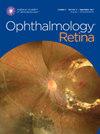Vitelliform Lesions Associated with Leptochoroid and Pseudodrusen
IF 4.4
Q1 OPHTHALMOLOGY
引用次数: 0
Abstract
Objective
To characterize clinical and prognostic implications of leptovitelliform maculopathy (LVM), a distinctive phenotype of vitelliform lesion characterized by the coexistence of subretinal drusenoid deposits (SDDs) and leptochoroid.
Design
Retrospective, cohort study.
Subjects
The study compared patients affected by LVM with cohorts displaying a similar phenotypic spectrum. This included patients with acquired vitelliform lesions (AVLs) and those with SDDs alone.
Methods
A total of 60 eyes of 60 patients were included, of which 20 eyes had LVM, 20 eyes had AVLs, and the remaining had SDDs. Patients >50 years of age with complete medical records and multimodal imaging for ≥6 months of follow-up, including color fundus photography or MultiColor imaging, OCT, fundus autofluorescence, and OCT angiography were included.
Main Outcome Measures
Choroidal vascularity index (CVI); proportion of late-stage complications (macular neovascularization, atrophy).
Results
The AVL subgroup exhibited a significantly higher CVI compared with both LVM (P = 0.001) and SDD subgroups (P < 0.001). The proportion of late-stage complications significantly differed among subgroups (chi-square = 7.5, P = 0.02). Eyes with LVM presented the greatest proportion of complications (55%) after a mean of 29.3 months, whereas the remaining eyes presented a similar proportion of complications, including 20% in the AVL group after 27.6 months and 20% in the SDD group after 36.9 months. Kaplan–Meier estimates of survival demonstrated a significant difference in atrophy development between groups (P < 0.001), with a median survival of 3.9 years for the LVM group and 7.1 years for controls. The presence of LVM correlated with a fourfold increase in the likelihood of developing complications.
Conclusions
Leptovitelliform maculopathy, characterized by the association of vitelliform lesions with SDDs and leptochoroid, represents a distinct clinical phenotype in the broader spectrum of vitelliform lesions. The importance of a clinical distinction for these lesions is crucial due to their higher propensity for faster progression and elevated rate of complications, particularly atrophic conversion.
Financial Disclosure(s)
Proprietary or commercial disclosure may be found in the Footnotes and Disclosures at the end of this article.
玻璃体病变,伴有白细胞增多症和假性白细胞增多症。
目的LVM是玻璃体病变的一种独特表型,其特点是视网膜下类风湿沉积(SDD)和类风湿黄斑同时存在:设计:回顾性队列研究:该研究将患有玻璃体黄斑病变的患者与表现出相似表型谱的队列进行比较。其中包括获得性玻璃体病变(AVL)患者和单纯 SDD 患者:方法:共纳入了 60 名患者的 60 只眼睛,其中 20 只眼睛患有 LVM,20 只眼睛患有 AVL,其余的患有 SDD。纳入的患者年龄在 50 岁以上,有完整的病历和至少 6 个月的多模态成像随访,包括彩色眼底照片(CFP)或 MultiColor、光学相干断层扫描(OCT)、眼底自动荧光(FAF)和 OCT 血管造影(OCTA):脉络膜血管指数(CVI);晚期并发症(黄斑新生血管、萎缩)比例:结果:AVL亚组的CVI明显高于LVM亚组(P2=7.5,P=0.02)。LVM患者在平均29.3个月后出现并发症的比例最高(55%),其余患者出现并发症的比例相似,其中AVL患者在27.6个月后出现并发症的比例为20%,SDD患者在36.9个月后出现并发症的比例为20%。Kaplan-Meier估计存活率表明,不同组间的萎缩发展程度存在显著差异(p结论:鳞状玻璃体黄斑病变的特点是玻璃体病变与 SDD 和类风湿关节炎相关联,它代表了更广泛的玻璃体病变中一种独特的临床表型。由于这些病变更倾向于快速发展,并发症的发生率也更高,尤其是向萎缩性转化,因此临床区分这些病变至关重要。
本文章由计算机程序翻译,如有差异,请以英文原文为准。
求助全文
约1分钟内获得全文
求助全文

 求助内容:
求助内容: 应助结果提醒方式:
应助结果提醒方式:


